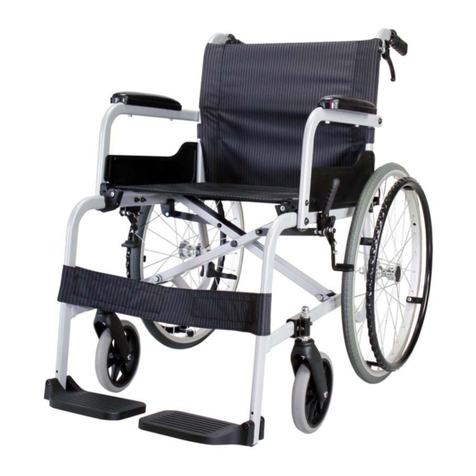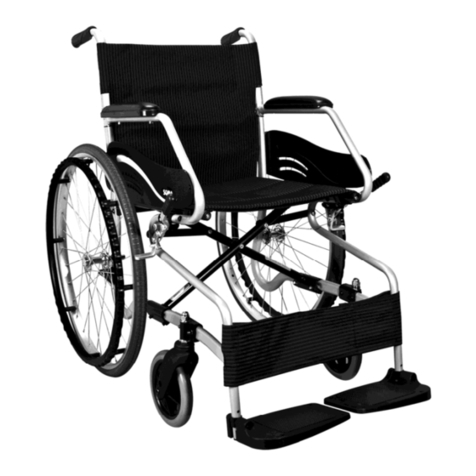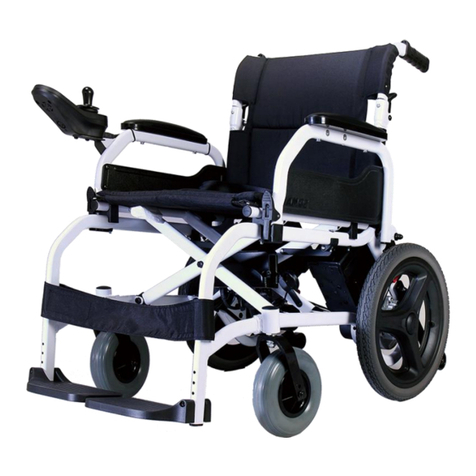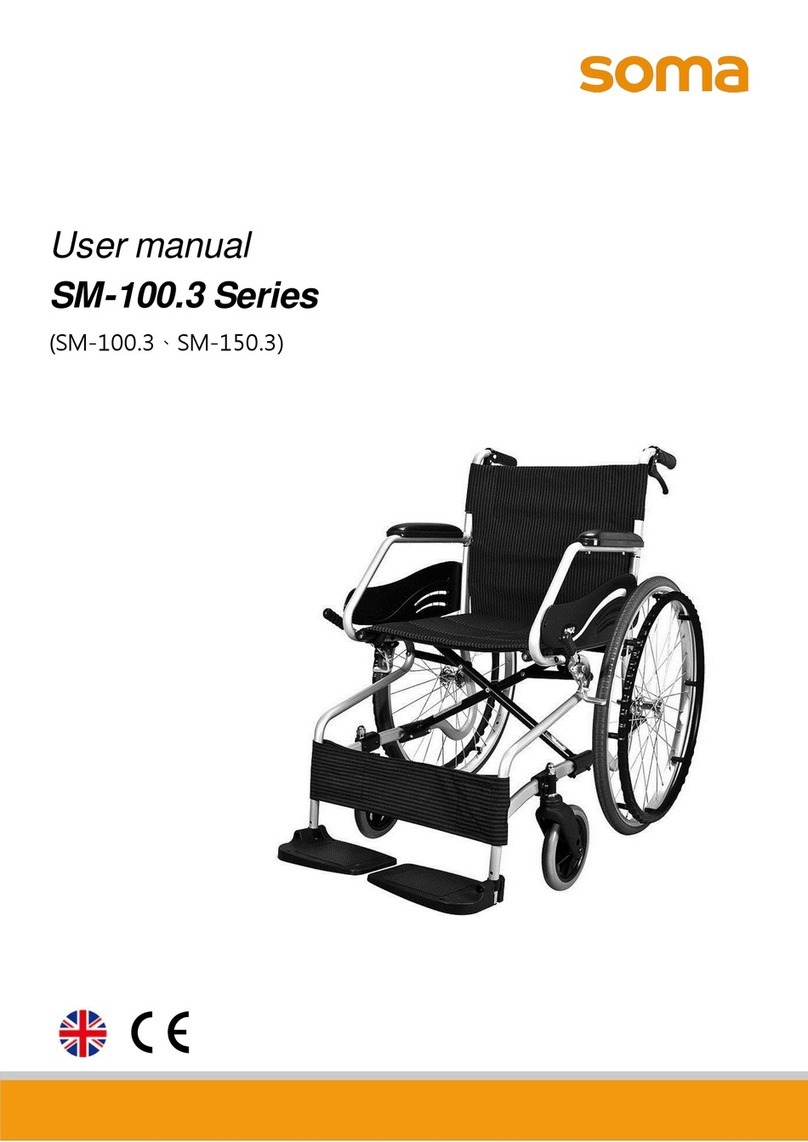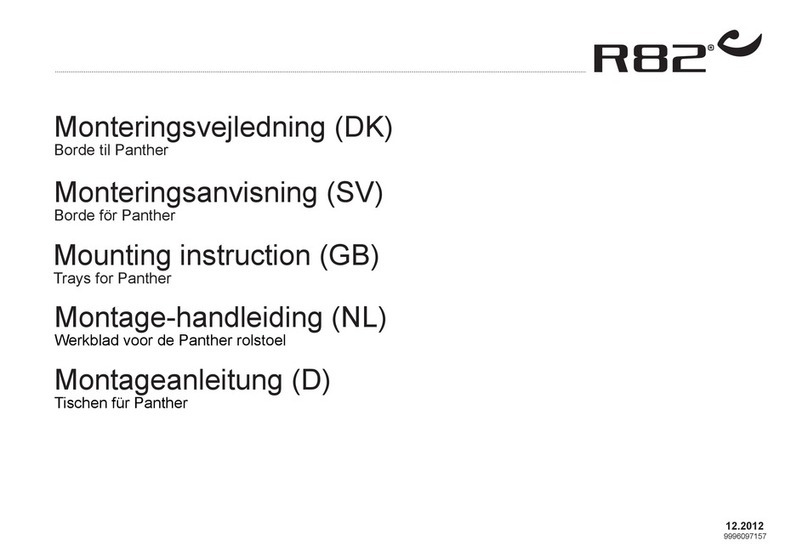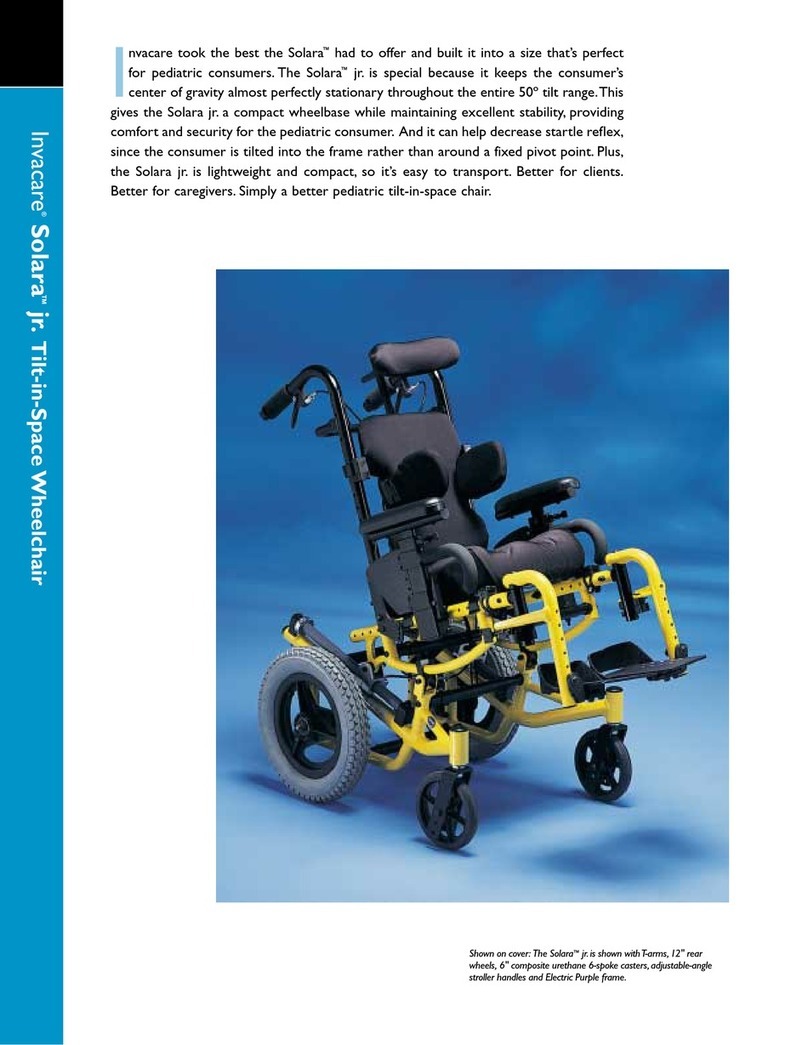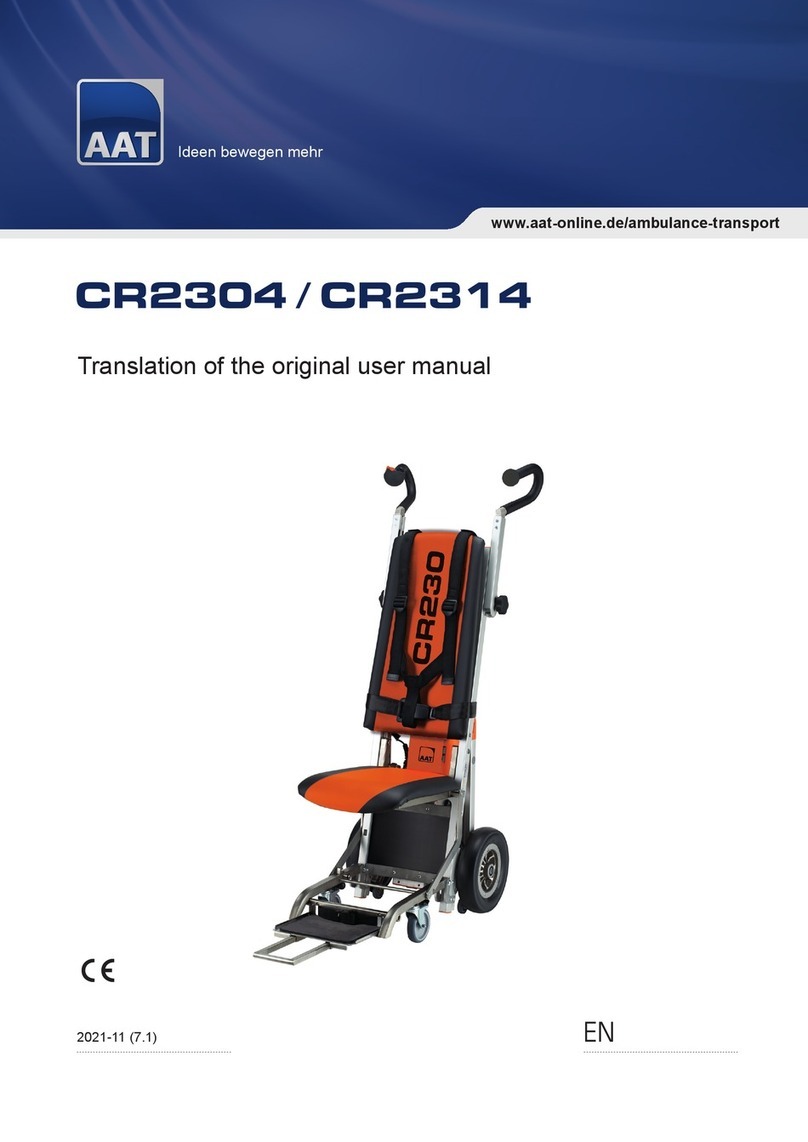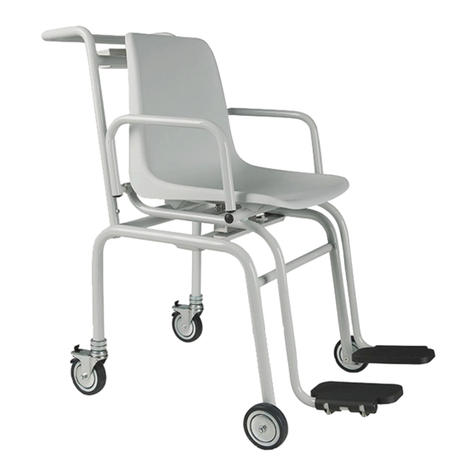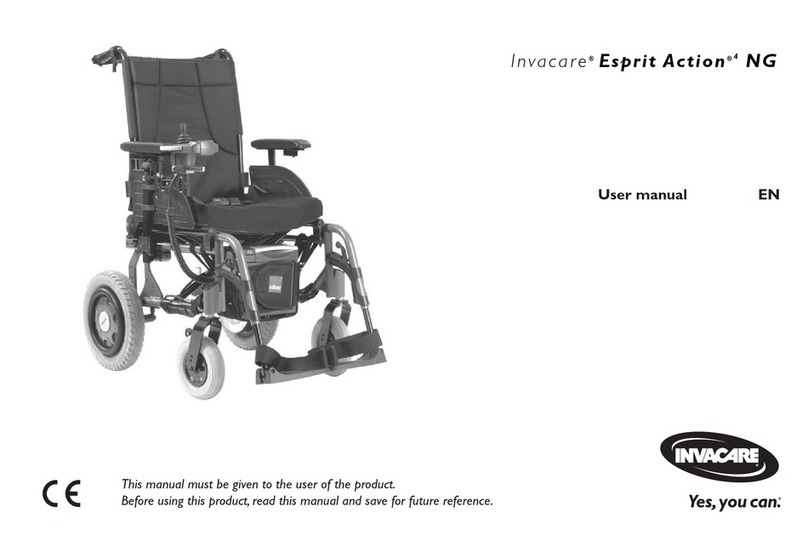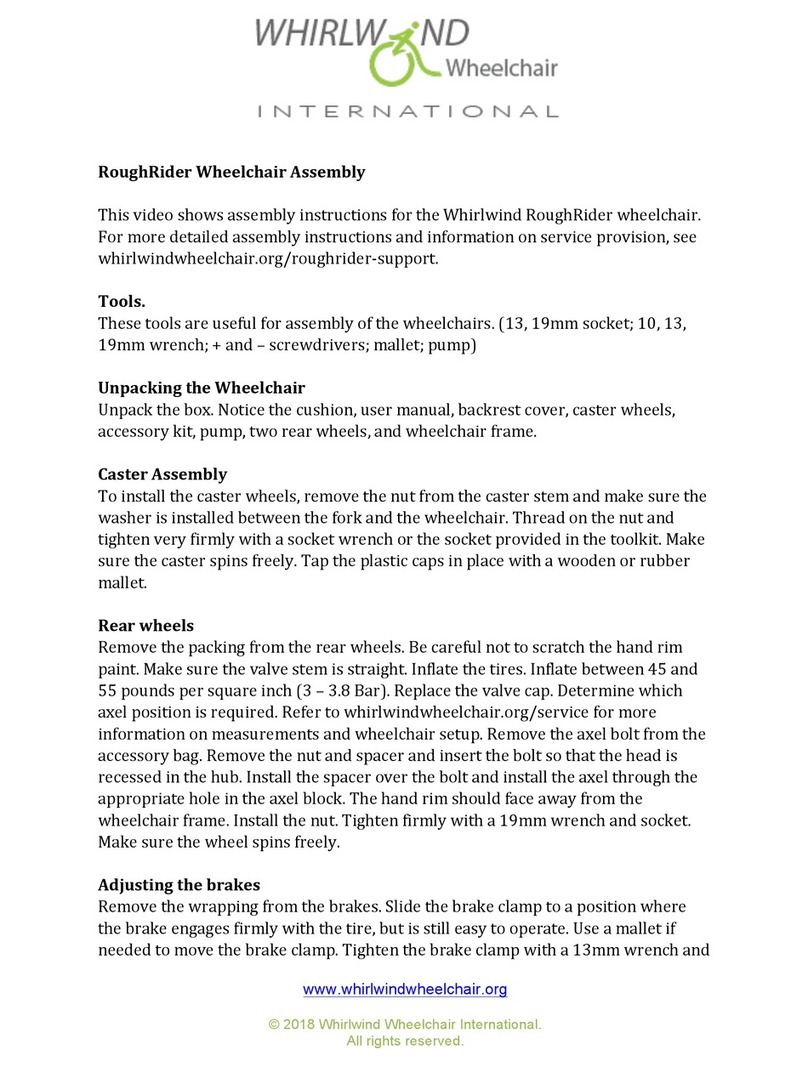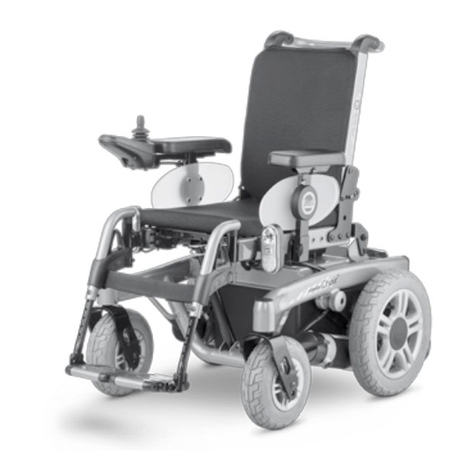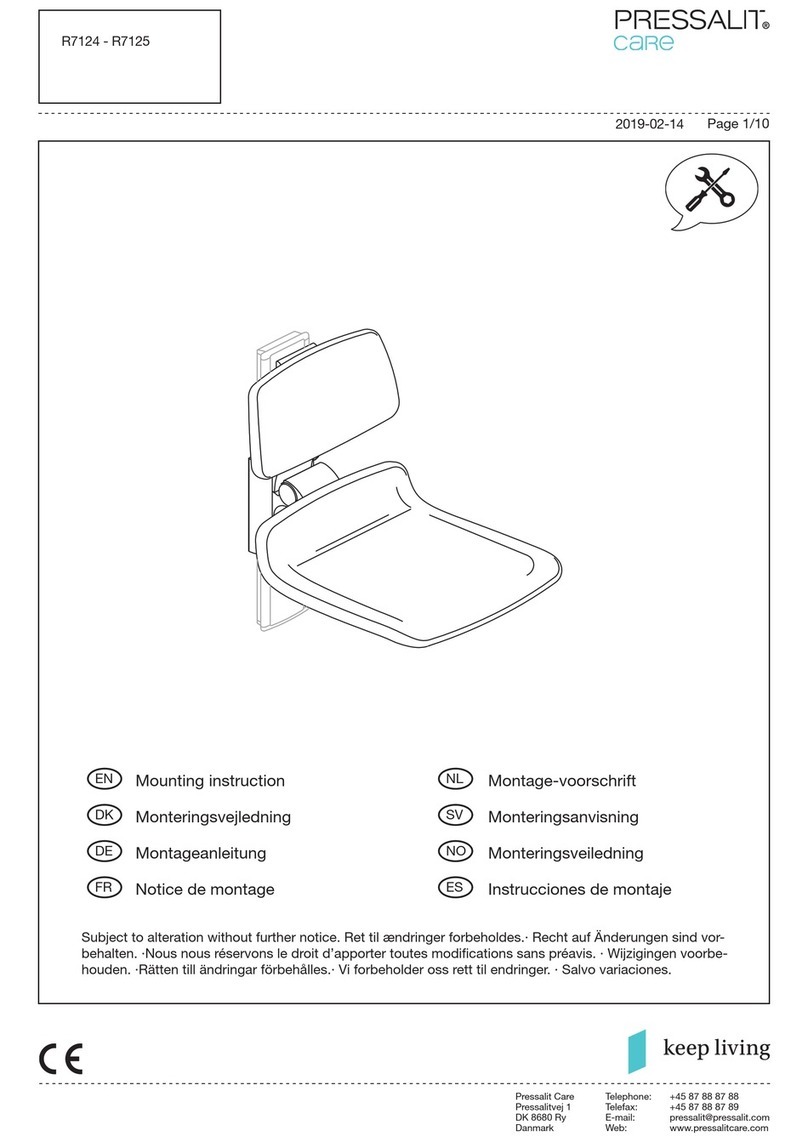SOMA CHM 100 Series User manual

Manual Wheelchair Owner's Manual
CHM 100 Series
(CHM 100& CHM 105)

I
GENERAL WARNING
DO make sure both brakes are applied before getting in or out of the chair or the
chair is not being pushed.
DO take care when climbing curbs or turning on slopes.
DO avoid steep or uneven surfaces that may cause the chair to tip over.
DO make sure that both feet are safely on the footrests and that clothing is safely
tucked out of the way so that it cannot get caught in the wheels.
DO keep both hands on the push handles to control the chair, if you are the
attendant.
DO pay attention to keep the chair balanced.
DO fix the upholstery or replace with a new one when it became loose.
DO equip with anti-tippers to avoid falling backwards.
DO NOT overload the chair in any circumstance.
DO NOT hang anything heavy on the back of the chair that could cause the chair to
become unstable, particularly when negotiating inclines.
DO NOT use other transport to pull the wheelchair.
DO NOT do "wheelies", since you my fall or tip over backwards and suffer a severe
injury.
CHM 100 or CHM 105 was not designed to be used in a moving vehicle.
DO NOT go too fast or turn too quickly.
DO NOT stand on the footplates when getting in or out of the chair.
DO NOT go down steps forward, whether solo or with an attendant.
DO NOT hang anything on the back joint that could cause the backrest folding
suddenly and may cause injury.
CE MARKING
This wheelchair complies with the requirements of the Medical Devices Directive
93/42/EEC.

1
1. PREFACE
Please carefully read this owner's manual before using the wheelchair. Improper use of
the wheelchair could result in harm or injury.
1.1 This owner's manual includes operation instructions for the aspects of the
wheelchair, unfolding/folding instructions and instructions on how to deal with
possible accidents.
1.2 As designs change, some illustrations and pictures in this owner's manual may not
correspond to the wheelchair that you purchased. We reserve the right to make
design modifications without further notice.
1.3 Whenever possible, please get help from an assistant/attendant while going on
inclines, curbs or stairs.
2. SAFETY
2.1 Doorways
The safest way to operate the chair is on level floors that are free of obstacles.
Whenever possible use a ramp to enter or exit a facility. Keeping your hands on the
push rims will allow you to maintain maximum balance. Do not try to force yourself
over an obstruction by propulsion and never use the sides of a doorway to pull
yourself through a passageway.
2.2 Leaning
Do not lean over the side of your wheelchair since such an action may cause you to
lose balance and fall. (See Figure 2.3)
2.3 Negotiating Inclines
2.3.1 Never turn on a hill due to the danger of tipping.
2.3.2 When assisting, go straight up a slope. If user needs to go down midway, walk
backwards until user is on level ground. (See Figures 2.4 and 2.5)
2.3.3 Avoid stopping on an incline; it can potentially cause you to lose control of the
chair.
2.4 Kerb(Curbs)

2
2.4.1 Avoid hard impacts when descending a curb. A hard impact could adversely affect
the chair.
2.4.2 Never try to scale or descend curbs that exceed a normal height (30-50mm).
2.4.3 Always be careful when climbing curbs and never move up or down a curb in
reverse without an assistant.
2.5 General
2.5.1 Always make sure BOTH brakes are applied before getting in or out of the chair.
2.5.2 Never stand on the footplates when getting in or out of the chair.
2.5.3 Use caution to assure your clothing doesn't get tangled with the wheels.
2.5.4 When the user is operating the wheelchair using the push rims, please push the
wheelchair gently. DO NOT apply a sudden huge force on the push rims. It could
cause the chair to tip over. Please refer to the figure below for the best grip points
for using the push rims.
2.6 Anti-tippers
Please purchase anti-tippers and always use them to avoid accidents.
2.7 Maximum User Weight Limit
The Max. User Weight is 100kg. Excessive maximum loads can damage your
wheelchair and cause malfunction which is not covered in warranty.
2.8 Avoid Misusing of the chair
2.8.1 Do not let children stand or play on the wheelchair. (See Figure 2.7)
Figure 2.3 Figure 2.4 Figure 2.5 Figure 2.6 Figure 2.7
3. OPERATION
3.1 Unfolding
3.1.1 Unfold the push handle. (See Figure 4.1)
3.1.2 Holding the armrests, pull outwards. (See Figure 4.2)

3
3.1.3 Pointing your fingers inward with the palm of your hand on the frame, push down
until the seat is fully lowered. Make sure the frame is firmly seated in its holder.
(See Figure 4.3)
3.1.4 Swing the footplates down. (See Figure 4.4)
Figure 4.1 Figure 4.2 Figure 4.3 Figure 4.4
CAUTION:
● When completing step 2, never put your fingers around the sides
or under the chair as they can be trapped between the seat and the
frame. (See Figure 4.5) Figure 4.5
3.2 Folding
3.2.1 Flip up the footplates. (See Figure 4.6)
3.2.2 Pull up on the seat upholstery by holding it in the center of its front and back edge.
(See Figure 4.7)
3.2.3 Press the two release levers on the backrest frame (push handle tubes) to fold the
backrest down for compact storage and easy transport (for CHM 105). (See Figure
4.8)
3.2.4 Folding is now completed.
Figure 4.6 Figure 4.7 Figure 4.8
3.5 Footrest installation and height adjustment
Install footrest:
3.5.1 Unpack the footrest box and take the footrest out of the box. Unscrew the screws
of the footrest by using 5mm Allen key which bundled in the tool box. (Figure 4-9).

4
3.5.2 Attach the sleeve to the front tube (slot side faces inwardly) and align it with the
hole. (Figure 4-10).
3.5.3 Fix the footrest with the sleeve and tube. (Figure 4-11).
3.5.4 Lock the footrest with screws and hex nut. (Figure 4-12)
Adjust footrest:
3.5.5 Loose screws by using 5mm Allen key which bundled in the tool box and adjust
the length to an appropriate position to fit user’s leg-length. (Figure 4-13).
Figure 4.9 Figure 4.10 Figure 4.11 Figure 4.12 Figure 4.13
3.5.6 Never stand on the footplates when getting into (or out of) the chair. (See
Figure4.14)
3.5.7 When transferring in and out of the chair, make sure that the brakes are applied to
prevent the chair from sliding away. Also see that the footplates are flipped up for
ease of entering or exiting. (See Figure 4.15)
Figure 4.14 Figure 4.15
3.6 Attendant Pushing and Self-propelled
3.6.1 Ensure that the brakes are always locked when the chair is not being pushed. (See
Figure 4.16)
3.6.2 Always make sure that both feet are safely on the footplates and that clothing is
safely tucked out of the way and cannot get caught in the wheels. (See Figure
4.17)
3.6.3 Always use both hands on the push handles to control the chair. (See Figure 4.18)
Figure 4.16 Figure 4.17 Figure 4.18

5
3.6.4 Always avoid steep or uneven surfaces because the chair may tip over. (See Figure
4.19)
3.6.5 Always avoid soft surfaces because the casters may get bogged down. (See Figure
4.20)
3.6.6 Always be careful not to go too fast or turn too quickly and try to achieve a
smooth steady ride.
3.6.7 Before crossing the tracks, please stop completely and look both ways.
3.6.8 Cross the tracks perpendicular to avoid your wheels getting stuck.
3.6.9 Do not drive at full speed over the railroad tracks.
3.6.10 Be careful going through a doorway that your hands and arms do not get injured.
3.6.11 PLEASE keep in contact with the person in the chair. If you stop to look in shop
windows or talk to people, remember to turn the chair so that the person in the
chair does not have to turn.
Figure 4.19 Figure 4.20 Figure 4.21
3.7 Tilting by the Attendant
3.7.1 Make sure both the user's feet are on the footplates and will not slip off. Make
sure the handgrips are secure and cannot slip off.
3.7.2 Release both brakes.
3.7.3 Grasp both push handles firmly.
3.7.4 Put your stronger foot on the relevant tipping lever at the back of the chair.
3.7.5 Tell the person in the chair that you are about to tilt the chair backwards.
3.7.6 Pull back with both hands and push down and forwards with the foot. This will
bring the chair onto the back wheels. (See Figure 4.21)

110400000541 Rev:04 2018.05
This manual suits for next models
2
Table of contents
Other SOMA Wheelchair manuals
